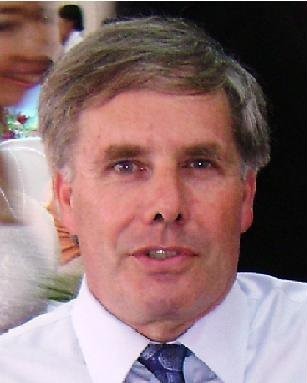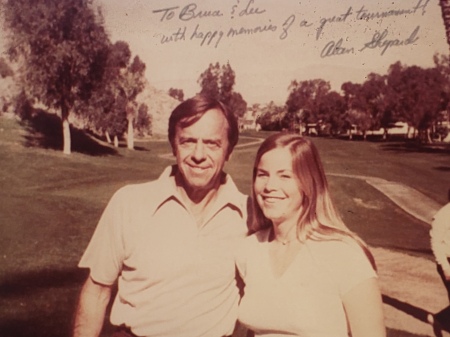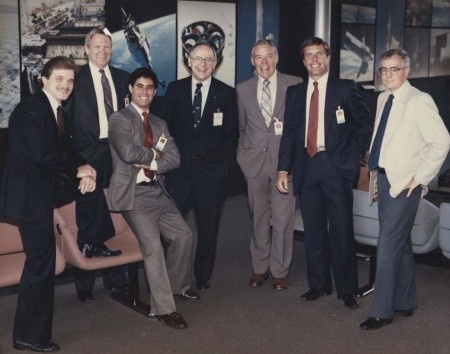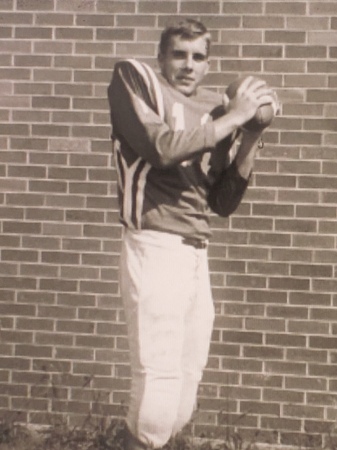Bruce Cordell:
CLASS OF 1967

Whitehall High SchoolClass of 1967
Whitehall, MI
Bruce's Story
*** I'll use this space to augment captions associated with photos in the Gallery.***
FOOTBALL (The THEN photo), TENNIS, MSU, UCLA & JIMMY CONNORS
I was really surprised and thrilled to be chosen All-Conference Quarterback for 1966. It may seem trivial now but I secretly wanted it, especially since I didn't plan to play college football. So I decided to give myself a chance by working out with weights for months before my senior summer -- and it really helped!
In fact, Coach Bekius made the All-Conference thing possible by allowing me to throw the football all over the field. And my receivers (Bob Funnell, Garrett Anguilm, Doug VanSlyke) were simply great! They were very patient with my sincere attempts at something sort of like a West Coast offense, occasionally punctuated with a longer ball when I thought no one would notice!
Unlike my experience in football -- where my receivers often made me look better than I actually was -- I was also a 4-year member of the WHS Tennis Team where surprisingly, I didn't seem as good to most people as I really was. This is because almost no one ever saw us play -- we played during the day, usually off-campus. Except for a couple matches my first year, I played 1st singles and never lost a conference tennis match the whole 4 years.
Friends who hear this story usually reply, "Well if you were so hot, why didn't you become a Spartan netter?" Of course, I wasn't sure I was that "hot", and also didn't want any distractions on my quest to become a PhD astronomer.
Well, after watching the Spartan tennis team close-up as a student for a year I knew they were beatable (even by me), but decided I'd rather be a first-rate astronomer than tennis champion of the Big 10! And indeed, my first year at UCLA removed any lingering doubts.
1971 was a big year for Jimmy Connors and me at UCLA: I was a 1st year graduate student and Jimmy was a Freshman. When I wasn't studying planetary & space physics or doing scientific research with my two faculty employers (one of whom became a member of the National Academy of Sciences!), I watched Jimmy practice and play tennis in-person and couldn't believe the speed and intensity! That year Jimmy became the first college freshman to win the men's singles NCAA championship, and he went on to become one of the all-time tennis greats winning multiple US Opens and Wimbledons. He still holds the all-time record for the number of men's singles championship titles (109). At UCLA my impression of Jimmy was that he had an "S" on his chest, wore a red cape, and was from another planet!
MORE ABOUT ASTRONAUT ALAN SHEPARD
Alan Shepard was a Navy test pilot who became a famous astronaut in the early 1960s. A few weeks after Russian Yuri Gargarin became the first human in space, Shepard became the first American (and 2nd human) in space in May 1961.
Because he was older than most Apollo astronauts, I only met Alan twice: Once accidentally at the Bob Hope Desert Classic golf tournament pro-am (see photo w ex-), and Second, at a big dinner in Houston honoring the career of the director of Jet Propulsion Lab (in Pasadena, CA). I went because I happened to be at Johnson Space Center (in Houston) and the GD bosses in San Diego called and told me they needed another General Dynamics person at the event. Indeed when Alan joined the drinks line before the dinner, I sprinted over to chat with one of the most colorful celebrities in the history of space exploration (see also next para).
After being plagued with an inner ear disorder that precluded spaceflight for many years, Shepard had experimental surgery that was successful and made him available for an Apollo mission to the Moon in January, 1971. Apollo 14 was the 3rd human landing on the Moon and the first in the lunar highlands at Fra Mauro. At 47 Shepard was (and still is) the oldest person to ever walk on the Moon. And at the end of their mission, Shepard, a big golf fan, used a makeshift golf club -- in full space suit -- to become the first human to hit a golf ball on the Moon; see YouTube.
GENERAL DYNAMICS IN SAN DIEGO AND PLANS FOR MARS
NASA wanted answers about how to get astronauts to Mars -- especially about safety, costs, and program viability -- and at GD we had a group that specialized in answers!
Without knowing much about it, as a high school student I had already staked-out a genuine interest in human voyages to Mars (see P. 67 in your '67 Viking yearbook!) that continued through a PhD in planetary science at Univ of Arizona (Tucson) and beyond. Indeed by 1990 my GD colleagues and I had coalesced around the exciting idea of going to the tiny moons of Mars (Phobos, Deimos) FIRST, BEFORE landing on Mars itself! This would actually cut the cost, crew, and schedule risks in half (over a Mars FIRST program), and would save the exciting, dangerous stuff -- the Mars landing itself - for months later whenever the astronauts and the amazed public audience on Earth felt like it, and the network news cameras were ready. By the mid-1990s even NASA had begun to warm up; e.g., a well-known NASA scientist independently advocated the Case for Phobos by referencing one of my AIAA papers of 1989: "Quoting from Cordell, 'The Phobos/Deimos-then-Mars strategy, appears to have operational, resource, science, and colonization advantages over a "Mars-first" strategy.' "
EARLY PLANS FOR HUMAN MISSIONS TO MARS WERE DRIVEN BY "SCIENCE" UNTIL THE MID-1990s
But this was still controversial because of our interest in "colonization" (later called "settlement") of Mars; The rationale for early human Mars missions was "science", not colonization. For example, even as far back as the 1950s, the great Wernher von Braun -- who built the Saturn V that first launched humans to the Moon in 1969 -- designed his human Mars mission concept around a large, crewed, mobile Bio-Lab (see photo) that they'd drive from the Mars polar cap all the way to its equator, while studying Mars science! According to von Braun himself in 1954, "We'll be on Mars for 15 months, That's a long time -- but it still will be too short to learn all the science we'd like know about Mars."
This "mostly-science-emphasis" for human Mars missions was significantly weakened in the mid-1990s when Jet Propulsion Lab announced the "era of Mars rovers" -- i.e. robotic JPL spacecraft and rovers at Mars -- had produced detailed, essentially continuous explorations of Mars' surface and skies since then! While we all would prefer trained scientists to be actually on Mars' surface doing Mars science directly, most people agree that the "era of Mars rovers" has enabled scientists at JPL to do almost as well.
Imagine this phone call in 1995 from NASA HQ to Dr. von Braun, " Hi Wernher, how's everything? I have to report that many NASA and government types are asking out loud why you c...Expand for more
ontinue to advocate dangerous missions to Mars that risk the lives of their crews and cost a fortune. Wouldn't it be better (sarcastically) to simply escort the crew to Pasadena for a similar, safer, cheaper scientific experience?"
Because Dr. von Braun sadly died in 1977, this conversation never occurred, but what would he have replied? My guess is, "While science is of great importance during human missions to Mars, our primary motivation is to provide an opportunity for human settlement on Mars by making possible the expansion of human civilization into the Cosmos."
Interestingly, the superb efforts of JPL's radio and robotics space engineers have gradually legitimized the colonization of Mars as the key motivation for human missions to Mars, including The Case For Phobos! This was symbolically demonstrated in 2007 when AIAA (the space engineer professional organization) formed a new Technical Committee on Space Colonization (since re-titled the TC on Space Settlement) and penned a white paper advocating major settlements on the Moon!
TRUMP POINTED NASA BACK TOWARD THE MOON
The election of President Trump in 2016 triggered a renewed interest in deep space human spaceflight at NASA and elsewhere. In 2025, NASA's Artemis Moon program will feature the first landing of a woman on the Moon and exploration of permanently shadowed south polar lunar craters with large subsurface frozen water deposits that could support future bases or cities on (or near) the Moon. Although NASA chose Elon Musk's SpaceX to build the Lunar Lander for Artemis, SpaceX also continues designing and testing its launch vehicles and spacecraft for a possible first human landing on Mars within 10 years!
HUMAN EXPEDITIONS TO THE MOON AND MARS ARE CONNECTED
An important, often under-emphasized connection still exists between the Moon and Mars programs. Although Apollo astronauts operated on the Moon in 1/6g for short periods (days), and International Space Station (ISS) astronauts survived much longer (months) in ~zero g, it is still unknown what the lowest, long-term value of gravity is that can maintain human bio-systems in space. Future Artemis-related experiments on the Moon in 1/6g may determine if artificial-g systems will be required on spacecraft en route to Mars or even on the Mars surface itself (1/3 g); centrifuges will be needed on Phobos with its mlli-g surface.
THE CASE FOR PHOBOS AND AN INTERPLANETARY ECONOMY
In the early 1980s -- before I joined General Dynamics -- it seemed likely to me that if local Mars resources (e.g., H2O) could be mined and used in the vicinity of Mars -- and eventually also used near the Moon! -- this might accelerate Mars program schedules and reduce costs. At this time, the prevailing scientific belief was that Phobos and Deimos ("PhD") had significant water ice in their cores and that the Moon was relatively dry. If PhD waters were mined, transported back by space tanker to the Earth-Moon system, and captured either near or on the Moon, we would have the first real example of a "profitable interplanetary economy" featuring "irrigation" of the Moon by waters from Mars! Preliminary design numbers (including costs) looked good and the first public exposure of this concept was in Space Calendar Weekly for May 13,1985 (see diagram).
My Advanced Space Systems group at GD continued to develop better models of PhD water mining and interplanetary transfer of water by space tanker to the Moon, geophysical models of the PhD moons themselves, and economic models of potential system profits, all supported by internal GD Corporate funds.
In more recent times, newer models for the asteroid and planetary origin of PhD suggest they may be drier than believed in the 1980s, and that recent international spacecraft observations of the Moon (e.g., Clementine, Lunar Prospector, LRO) indicate that large impact basins near the lunar polar regions have major subsurface deposits of water ice. A key goal of NASA's Artemis program is to ascertain the size of water deposits on the Moon. Although the composition of Phobos' interior is unknown, it has a very porous interior (30% +-5%) so ice below the surface regolith is possible. Numerous Phobos mission concepts are under consideration by NASA and others including orbiters, flybys, landers, and sample returns.
CURRENT PROSPECTS FOR HUMAN VOYAGES TO MARS AND MANAGING RISK
In my humble opinion, we could have landed the first humans on Mars at least 20+ years ago if NASA had taken our (and others') advice. Of course NASA does not make decisions about sending humans into deep space in a vacuum (pun intended). Instead, the costs, risks, and national prestige aspects of human Mars voyages always make them political issues.
We've already mentioned the two major risks that remain for Mars astronauts: 1) radiation, and 2) gravity (which we've covered before), but I don't want you to fear them, and here's why. Every once in a while the "radiation hucksters" -- as Robert Zubrin, ace space engineer and founder of The Mars Society, calls them -- write another paper insisting the cancer risks are too large for a Mars mission. But because the dangerous galactic cosmic ray (GCR) dose rates are about 1/2 in low Earth orbit (where the International Space Station is) of what they are in interplanetary space (where the Mars crew is), Bob is fond of pointing out that several ISS crew members have already received the full GCR doses of a typical Mars crew!
MONDAY-MORNING QUARTERBACKING GUIDES THE MARS PROGRAM SEQUENCE
People are also sensitive to the public relations aspects of a human Mars program -- because in classic Monday - morning quarterbacking style -- they want to avoid the rapid decline of public interest in the Apollo Moon program of the late 1960s. The Phobos-first program is ideal for keeping the earthbound public riveted as initial space targets (including human missions to the Moon, e.g., Artemis) transition over many months (and potentially even years) into intermediate intensity targets (including humans to Phobos and Deimos and their bases) which eventually culminate into The Big One -- the first human landing on Mars! However, TBO is just the first of several surface landings -- a global tour on Mars -- including the largest volcanoes known anywhere, the North American-size canyon lands, and the icy polar caps where water and evidence for current Martian life might lurk! As the excitement increases more Earthlings will decide to become the first generation of Martians, and begin the settlement of Mars!
INTRODUCING THE CASE FOR PHOBOS TO THE REAL WORLD: IS INTERNATIONAL COOPERATION POSSIBLE IN A WORLD WITH MULTIPLE MAJOR WARS?
tbd...
.
Register for Free to view all details!
Yearbooks
Reunions
Register for Free to start a reunion event!
Photos






